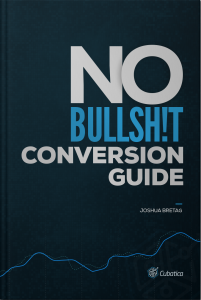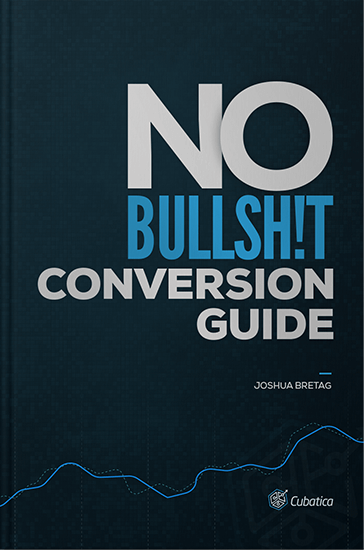The Definitive, No-BS Guide to Increasing Conversions (PHASE IV)
PHASE IV: MORE ANALYSIS

Step 8: Quantitative Analysis
The main things to look for during a GA Health Check are:
- Does it collect the data I need?
- Can I trust the data?
- Are there holes in the data or inaccuracies?
- Is there anything that can be fixed?
- Is anything in GA broken?
- What reports or reporting periods should be avoided?
- Have annotations been added for the bad data periods, launches etc..?
- Do I have the reports and goals I need to report on the data that matters?
- How has the current setup been created and why?
With these questions in mind, review the Google Analytics account again using the GA Health Checklist. It is critical that each part of the GA account is setup properly.
Do not base successful tests on bad data. – Click to tweet
When everything is in order, collaborate with the client or Project Manager to identify areas of focus and the metric (reports + data) that will be used to determine the success or failure of each test. If this isn’t for a client and you are optimizing your own site, bring together your team and hash-out which data points will mean the most.
Use the GA report to highlight issues that need further analysis. Remember, that GA reports cannot identify the specific issue with a page, only that an issue exists.
Content Reports
Use content reports to identify:
- High-traffic pages with low conversion rates, high bounce rates and exits
- Does the traffic landing on the page match the page’s messaging?
- Conduct split testing until your conversion rates on the page(s) improves; indicating that you have landed on the right copy/message for the audience.
- Does the traffic landing on the page match the page’s messaging?
- Pages that have lower than site average conversion rates
- Is the value proposition stated clearly and does it differentiate you from competitors?
- Include a value proposition for both your product and your company. Convince readers that you not only have the best product but are also the best place to get that product.
- Does the traffic landing on the page(s) match the page’s message?
- Is the value proposition stated clearly and does it differentiate you from competitors?
- Landing pages with higher than site average bounce and exit rates
- Does it take longer than 4 seconds for the page to load?
- Any longer than 4 seconds means there is room for improvement.
- Are there too many alternative offers and ads?
- Do not use auto-play – if someone wants to see your hilarious video, they will click on it.
- Consider banner ads carefully – they need to be relevant to your visitor and related to the material on the page.
- Can users skim the page and quickly get their answers?
- This isn’t a novel. No one wants to read it cover-to-cover. Make the facts easy to find.
- Does it take longer than 4 seconds for the page to load?
- Landing pages with lower than site average conversion rates
- Have you addressed objections?
- List all of the possible objections your reader may have and add enough information or links to address each one.
- Are you using jargon? Stop!
- Write to people. Real breathing humans want clarity, not a bunch of meaningless corporate-speak.
- Have you addressed objections?
Use this report to learn:
- Which navigation links are used on specific pages? Do they need to be renamed or removed?
- Are there any links on the page that are distracting from the one goal of that page? Can they be removed? (using the enhanced link attribution of GA tracking)
Screen Resolutions, Browsers & Devices
A light review of this area was accomplished during the GA Health Check; anything “major” that jumped out from a technical standpoint should have already been repaired before reaching this stage.
Now it is time for a more in-depth and revealing analysis.
Browsers:
- Which browsers and browser versions have lower than site average conversion rates? (need 100+ transactions or goals to be somewhat accurate)
- Which browsers have high bounce and high exit rates? (and at which specific stages in the funnel?)
Devices:
- What is the distribution between desktop, tablet and mobile?
- What has the device trend been over the last 3, 6 and 12 months? (used to determine if this segment should be taken seriously)
- What are the lowest converting devices? Why are they converting low?
- Which pages have the highest bounce and exit rates on which devices(need page views over 1000+ views)
Resolutions:
- What is the segmentation of users on Mac versus Windows? (add to overall market data – specific OS users do have common traits)
- What is the most common screen resolution? (add to overall market data)
- Which resolutions have lower than site average conversions? Are there usability issues on these resolutions?
- Which pages are showing the highest bounce rate and the highest exit rate for each resolution?
- Where is the biggest drop-off on the lower than site average conversion resolutions?
Walkthrough the main user journey of the lowest-performing (low conversion rate or high bounce-rate) device, browser and/or resolution using the specific device, browser or resolution in question. Identify potential issues and add each to the optimization requirements sheet.
Don’t have a library of devices and browsers at your disposal? No worries, these guys have got you covered:
![]()
- Remote TestKit: Remotely access over 350 Android and iOS smartphones from around the globe
![]()
- Perfecto: Test web and mobile apps on multiple devices, browsers, networks, locations and operating systems in the cloud – even offers testing using real-user conditions based on user personas
![]()
- Soasta: Cloud-based emulator that enables testing on more than 300 devices
![]()
- MacinCloud: A pay-as-you-go solution for remotely testing on rented Mac servers
![]()
- BrowserShots: Provides a super-quick look at how your pages display on almost any browser
There are a handful of companies that rent-out physical devices or provided a simulated environment for testing. In some cases, testing must be completed on-site; in others, the company will mail you a device ready to test.
The providers of physical hardware are location-specific and generally charge a per-a-minute fee for use of a carrier’s network or a flat-rate if the device will be connected to Wi-Fi.
Site Search
When conducting a site search, use this report in conjunction with the following questions:
- How is search being used on the site? Could an FAQ section answer this need?
- What are people looking for on the site? Does the content need to be displayed better or is it incomplete?
- What new business opportunities can I glean from this information?
- Are the visitors that are searching the site converting higher than other traffic? If yes, should site search be more prominent?
Add the results to the Research / Analysis Sheet and rank it according to the overall conversion impact it will have on the site.
Key Audience Insights
The goal of key audience insights is to gather information about the market. Look for insights on possible conversion uplifts and data to add to the persona profiles.
Before running the reports, filter-out all regions without 100 goal completions or transactions.
The resulting reports answer the following:
- What are the top traffic regions/locations?
- What regions/locations have lower than site average conversion rates?
- What is the split of new versus returning visitors? (does this site have a high volume of return visitors?)
- Is the conversion rate for new visitors lower than the site average? (may indicate possible usability issues)
- What are the ages of the market? Which age groups are converting lower than the site average? Which age groups are converting higher than the site average? Why?
- Which Affinity Categories have high conversion rates? (create more of this type of content)
The key audience insights provide a better understanding of the targeted marketplace and highlights which groups of visitors are converting and which are not. This information is needed to dig into the “why” of low converting groups.
The results also reveal which content is working in the targeted market place.
Mouse Tracking
Implement mouse tracking on the site and use it to answer the following:
- What gets noticed and what doesn’t?
- Where do people click and where don’t they click?
- How far do visitors scroll down any given page?
- Are people clicking an area expecting it to do something?
- What issues are users encountering? (answer this by reviewing recorded User Sessions to see how are visitors are filling out forms on the site)
After collecting this information from the mouse tracking maps and recorded User Sessions, add key areas of interest to the Research / Analysis Sheet.
Ring Model Check
When the Google Analytics Health Check is complete, conduct a quick ring model analysis using this template.
Use the analysis to determine which page in the sequence will have the most positive impact on increasing conversions. This approach is especially effective if there is bad data in the analytics tool.
For example, if there are 3,000 product pageviews; 5,000 cart-adds and only 1,000 checkouts there is clearly a problem at the cart-add stage. However, if the total checkouts were only 100, the problem is at the checkout stage.
Phase V: Content and Testing here.

The Definitive No-BS Guide to Increasing Conversions
How to Kill It in the Conversion Game
100% Privacy. No BS. no games, no spam, When you signup.
we’ll keep you posted with a few emails per week



